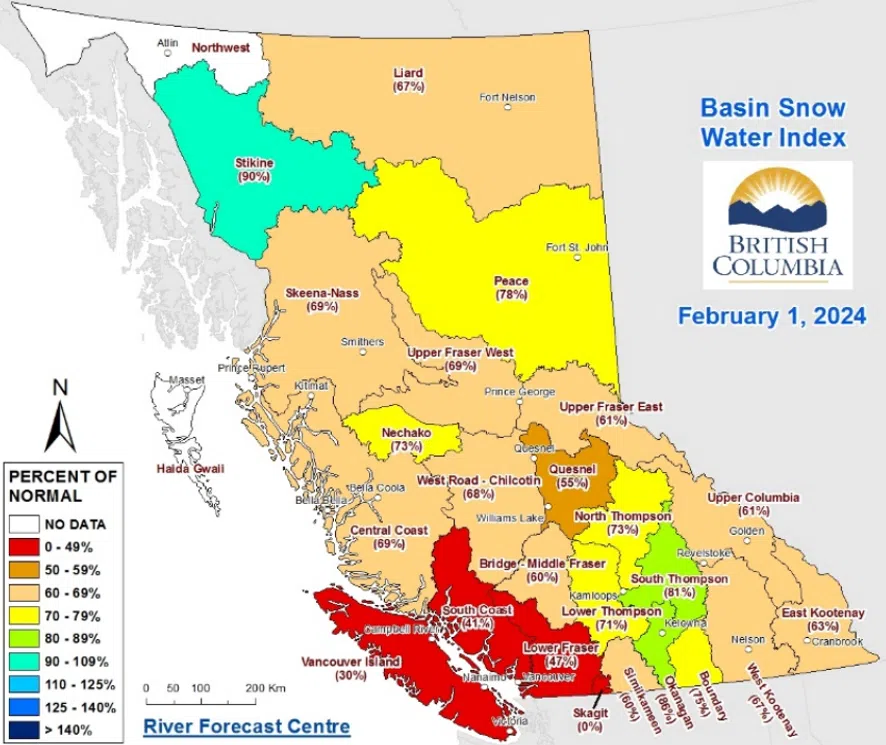
A map at the various snowpacks across B.C. as of Feb. 1, 2024. (Photo via BC River Forecast Centre)
B.C.’s average snowpack is almost 40 per cent lower than normal, raising concerns about what Premier David Eby says are “some of the most dramatic drought conditions that have been seen in our lifetime.”
The province’s latest snow bulletin says levels remain “very low” at 61 per cent of normal, compared to 79 per cent of normal this time last year. February’s data is a slight increase from the 56 per cent normal recorded last month.
“Extreme cold temperatures mid-month and extreme warm conditions late-month resulted in overall monthly temperatures close to normal for January,” the BC River Forecast Centre said in a statement.
“Low snowpack and seasonal runoff forecasts combined with warm seasonal weather forecasts and lingering impacts from previous drought are creating significantly elevated drought hazards for this upcoming spring and summer.”
In the Kamloops-area, the North Thompson snowpack is sitting at 73 per cent of normal – up from 60 per cent last month – while the South Thompson is at 81 per cent – up from 73 per cent.
“Due to the extremely low snow conditions, below normal spring freshet flood hazard is expected this season, especially in the Interior,” the River Forecast Centre added.
The bulletin shows the snowpack is especially sparse across the South Coast, ranging from 30 per cent of normal on Vancouver Island to 47 per cent in the Lower Fraser region.
The Stikine region in northwestern B.C. has the highest snowpack in the province at 90 per cent of the average, while the Skagit region reported no snowpack.
Elsewhere in B.C., the Okanagan snowpack was up from 64 to 86 per cent, the Middle Fraser snowpack was up from 50 to 59 per cent, the Lower Thompson – a sub-basin of the Middle Fraser – nearly doubled to 71 per cent, as did the Similkameen which went from 32 to 60 per cent of normal.

A look at the various snow indices across B.C. as of Feb. 1, 2024. (Photo via BC River Forecast Centre)
Just yesterday, the B.C. government announced plans to host a series of workshops to help farmers prepare for a potential drought this summer.
Eby says he’s “really worried” about the coming summer, and the only thing that “eclipses” his concern about drought is watching atmospheric rivers of rain sweep over California, causing landslides and flooding that have killed several people.
The premier says it feels like the extreme weather B.C. is experiencing is an “early warning sign for the rest of Canada about what’s coming with climate change.”
“The first week of February was drier than normal,” the River Forecast Centre said. “Weather forecasts for the upcoming 7-10 days predict continued relatively dry conditions through the province.”
“There are still [two to three] months left in the snow season. While conditions may change slightly over this period, current trends in low snowpack are expected to persist.”
The next release of snowpack data is scheduled for March 8.
For the entire Snow Survey and Water Supply Bulletin report, go here.
– With files from The Canadian Press















